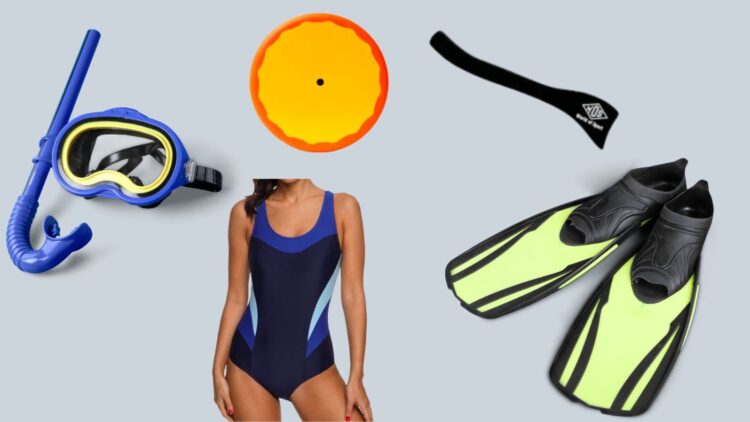
OBJECTIVE OF UNDERWATER HOCKEY: Score more goals than the opposing team by pushing the puck into the opposing team’s underwater goal.
NUMBER OF PLAYERS: 20 players, 10 on each team (6 playing, 4 on the bench)
MATERIALS: Puck, diving mask, snorkel, diving fins, pusher, swimwear
TYPE OF GAME: Sport
AUDIENCE: 10+
OVERVIEW OF UNDERWATER HOCKEY
Underwater hockey, also known in some countries as “Octopush”, is exactly as its name suggests—an underwater version of hockey. Played on the bottom of a swimming pool, underwater hockey sees players hold their breath while attempting to slide a puck into the opposing team’s underwater goal.
There is some disagreement as to where underwater hockey originated. Some claim it was the invention of Alan Blake and his team of divers, while others claim it started as a conditioning exercise for the divers of the British Royal Navy. Regardless of its exact origins, this strange and extremely challenging sport originated in Britain in the early 1950s.
This sport was initially called Octopush because it was meant to be played by teams of eight players who pushed the underwater puck around with specialized sticks called “pushers”. However, this term has mainly only ever been used by the British, with most other countries adopting the more literal name of underwater hockey.
As a modern sport, underwater hockey is played and competed in by more than 40 countries worldwide. However, the sport still considerably lacks popularity, not just because of its obscure gameplay. Much of the reason for this lack of popularity is that the sport is not very spectator-friendly. As the entire sport is played underwater, spectators are forced to watch the game through the lens of underwater cameras. For this reason, it is unlikely that underwater hockey will ever become a major sport, although many spectators and players across the globe still love and follow this unique hockey variation.
SETUP
EQUIPMENT

- Puck: Underwater hockey pucks are roughly the same size as actual ice hockey pucks, but they’re made of lead and weigh about 3 pounds. A plastic covering is added to the lead puck that is modified to provide a good “grip” with a player’s pusher (stick), while also avoiding excessive friction with the material that makes up the pool floor.
- Diving Mask: A mask that protects an athlete’s face and allows them to see underwater. These masks also leave room for the athlete’s nose to breathe out in their mask, which is necessary to equalize the pressure of their mask with the pressure of the water, allowing them to avoid trauma from “mask squeeze”.
- Snorkel: A breathing tube that enables an athlete to catch their breath while still being able to keep their head underwater to watch what is going on beneath them.
- Diving Fins: Worn on the feet, these diving fins help an athlete swim faster.
- Pusher: A short hockey stick held in one hand used to move the puck underwater.
- Swimwear: This sport has no clothing/uniform requirements, but appropriate swimwear should be worn.
GAME FORMAT
An underwater hockey game consists of two halves that each last 10 to 15 minutes in length (but sometimes as long as 20 minutes), with this number depending on the tournament rules. The two halves are separated by a short halftime generally lasting 3 to 5 minutes.
TEAM FORMATIONS
Similar to hockey and soccer, underwater hockey teams utilize specific player formations. As no goalies exist in this sport, all six players on each team are used in these formations.
The most basic team formation is 3-3, which features three offensive players and three defenders. There is no actual limit to the customization of a formation, with some teams even including up to four different formation levels, such as a 2-1-2-1.
GAMEPLAY

An underwater hockey match consists of gameplay resembling other goal-based team sports like ice hockey, field hockey, and soccer. However, the underwater aspect of the sport, along with the fact that no goalies or contact are allowed, makes for an exciting pace of play.
Throughout the entirety of the match, roughly half of the players fight for the puck on the bottom of the pool, while the other half are above the water catching their breath. This creates a unique dynamic, as players must constantly leave the action and hope one of their teammates will fill in for them.
To add to the uniqueness of this sport, the fact that it takes place at the bottom of a deep pool means that a player can use the entire 3D space of the pool. For example, a defender can swoop down and swipe the puck out of a defender’s possession from above, likely without the other player even seeing them.
SCORING
Scoring in underwater hockey is as simple as pushing the puck into the opposing team’s goal. However, the goals used in this sport are unique and don’t resemble traditional goals or nets used in other sports.
Instead, underwater hockey goals are long pieces of metal that match the 90-degree, right-angle shape of the bottom edge of the pool. Each goal has a slightly inclined ramp (known as a “lip”) at its front. To score a goal, the puck must hit the back of the goal or fully land in the space between the back of the goal and the initial ramp (called the “trough”).
RULES
The rules of underwater hockey are pretty simple and easy. In fact, common rules seen in other sports, such as offsides, are not present in this sport. The rules of underwater hockey mainly include:
- The puck cannot be touched with anything other than a player’s stick.
- Intentional contact with other players isn’t allowed, and a player’s non-stick hand cannot be used to interfere with other players.
- Obstruction of other players is prohibited.
If any of these rules are broken, one of two underwater referees uses a hand signal to notify the chief referee sitting outside of the pool. This chief referee will then hit a button to sound a buzzer, which will alert the other players of the stoppage in play.
Depending on the nature and severity of the penalty, a team can be awarded a free kick similar to soccer, a two-on-one scoring opportunity, or a free penalty goal outright. Additionally, similar to ice hockey, an offending player may be “ejected” for a few minutes (creating a power play) or the entire game.
A SILENT GAME
What makes underwater hockey even more unique is that it is one of the few sports in which communication between teammates is nearly impossible. As most of the game takes place underwater, there is no talking. And unfortunately, there is simply too much going on for hand gestures to be used efficiently.
With that said, there has to be a way for players to be alerted of a stoppage in play. As mentioned, a loud buzzer that can be heard underwater helps with this. These buzzers signal when to start the match (including after each goal), when a goal is scored, when a half ends, or when a penalty is called.
END OF GAME
The team who scores the most points by the end of the second half wins the underwater hockey game.
- 30 GAMES TO PLAY OVER TEXT - April 22, 2024
- 20+ FREE PRINTABLE BABY SHOWER GAMES - April 16, 2024
- 20+ College Party Games for the Best Night Ever! - April 2, 2024